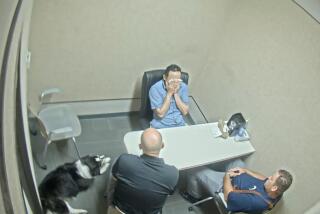Blood Found on Knott Is Peyer’s Type : Expert Witnesses Also Link Piece of Thread Found on Sweat Shirt
- Share via
Blood found on a boot of Cara Knott matched the blood type of CHP Officer Craig Peyer, who is charged with strangling the San Diego State University student on the night of Dec. 27, a police serologist said Thursday.
In addition, a police hair-fiber expert testified that a single microscopic piece of thread taken from Knott’s blood-stained sweat shirt matched thread samples taken from California Highway Patrol shoulder patches obtained from Peyer’s police jacket.
During the fourth day of Peyer’s preliminary hearing, Dr. Lee Bockhacker, the coroner’s pathologist who performed the autopsy, testified that Knott could have been strangled with a piece of rope that was found in the trunk of Peyer’s CHP cruiser.
San Diego police criminalist and blood expert Walter K.W. Fung said the blood sample taken from Knott’s left boot matched Peyer’s Type-A blood. Fung said Knott’s blood was Type O.
Trained in Self-Defense
Police criminalists discovered the “crusty” blood spot in a crease of the leather boot, between the sole and the top of the boot. Prosecutors have contended that Knott, who was trained in self-defense, scratched Peyer’s face when she was attacked, causing him to bleed.
“It was determined that Cara Knott could not have been the source of the blood on the boot, and Mr. Peyer could have been the source,” Fung said.
Knott, 20, was wearing the boots, purple sweat pants and a white sweat shirt when she was strangled on the old U.S. 395 bridge near Interstate 15 and the Mercy Road off-ramp. Her body was thrown off the bridge 75 feet into a dry creek bed, where it was discovered the next morning.
Peyer, 37, and a 13-year patrol veteran, was arrested Jan. 15. After the arrest, San Diego Police Chief Bill Kolender praised the scientific work done by police forensic specialists and said physical evidence uncovered by police technicians contributed directly to the arrest.
Some of that evidence was made public for the first time Thursday by Deputy Dist. Attys. Joseph van Orshoven and Jim Atkins, who methodically guided the expert witnesses through their complex testimony.
Robert Grimes, Peyer’s defense attorney, tried unsuccessfully to bar Fung from testifying as a blood expert. But Atkins questioned Fung, a San Diego police criminalist since 1979, at length about his qualifications, and Municipal Court Judge Frederic Link, who also questioned Fung, let him testify.
Under questioning by Grimes, Fung said that Peyer is among about 19% of the U.S. population with Type-A blood.
“He (Peyer) cannot be excluded as the donor of the blood (on the boot),” Grimes said. “But can he be included as a possible donor along with millions of people?”
Fung refused to speculate and suggested that he is not a demographics expert.
“Whether or not it’s millions, I don’t know,” he said.
Grimes also attempted to bar the press and public from hearing police hair-fiber expert John Simms’ testimony on the grounds that the art of fiber comparison is not an exact science. Making Simms’ testimony public before Peyer’s trial would jeopardize his client’s right to a fair hearing, Grimes said.
The defense attorney also complained that Simms had decided before Peyer’s arrest that the thread taken from Knott’s sweat shirt came from the patches on Peyer’s jacket.
“Mr. Simms apparently came to certain opinions in this case before an arrest warrant was issued,” Grimes said. “We have been unable to obtain the basis (Simms’ notes) for these opinions . . . until last week. We have not had sufficient opportunity to evaluate these (notes).”
Link rejected Grimes’ argument and allowed Simms to testify.
Threads Matched
Simms said that he found the piece of thread while examining Knott’s sweat shirt Jan. 8, 12 days after her death. San Diego police homicide investigators obtained CHP uniforms from different officers and Simms said that he matched the thread found on Knott’s sweat shirt to the patches on Peyer’s jacket.
Police evidence technician Barbara Beck said police recovered a uniform shirt and pants from Peyer’s home Jan. 8. A pair of pants, shirt and uniform jacket belonging to Peyer were taken the same day from his locker at the CHP office in San Diego.
Simms said that he compared the gold thread found on Knott’s sweat shirt to similar thread samples taken from uniforms belonging to other CHP officers. But the “microscopic characteristics” of the sample taken from the sweat shirt matched only the thread taken from the patches on Peyer’s jacket, Simms said.
Though he could not say “with any certainty” that the thread from the sweat shirt came from Peyer’s patches, Simms said that both thread samples had identical characteristics.
“Besides the color and shape . . . the surface of the fibers had a very distinctive sandblasted type of appearance. There is no essential difference,” Simms said.
The thread samples taken from the other CHP uniforms had a “very clear, smooth type of surface,” he said.
Origin of Thread
Grimes suggested that the thread found on Knott’s sweat shirt could have landed there when a bag containing Peyer’s jacket was opened or closed and the thread “floated into the atmosphere” of the police evidence room.
Simms said that was possible but that Peyer’s uniform items were not in the room when he examined the sweat shirt. In addition, Simms said, numerous pieces of thread, like the one found on the sweat shirt, were found on Peyer’s jacket.
Bockhacker, the last witness to testify Thursday, said that a piece of rope, 46 inches long, discovered in the trunk of Peyer’s patrol car could have been used to strangle Knott. The rope is not standard CHP equipment, a CHP official testified Wednesday.
The ligature marks found on Knott’s neck measured from one-fourth to three-eighths of an inch, Bockhacker said. The rope taken from the trunk is “consistent with the ligatures,” he said. “It could’ve been used in the strangulation.”
But under questioning by Grimes, Bockhacker said Knott could have been strangled with a rope as thin as a quarter of an inch.
Police investigators also revealed other pieces of evidence recovered at the bridge railing where Knott was killed. Homicide Lt. Phil Jarvis said he picked up several strands of hair from the railing. Simms later identified the hair as coming from Knott.
Beck testified that she recovered several magenta-colored fibers from the railing. Prosecutors suggested that the fibers came from Knott’s purple sweat pants. Jarvis said that the purple fibers and hair samples were found directly above the spot where Knott’s body landed in the creek bed.
Investigators also recovered blood and tissue samples from under the fingernails of Knott’s right hand. However, Fung said that it was impossible to determine the origin of the tissue samples and the “apparent” blood sample was not enough to test.
A blood sample was also recovered from the doorjamb of Knott’s Volkswagen, Beck said.
Link recessed the preliminary hearing until Monday, when the prosecution’s final witness is scheduled to testify. So far, prosecutors have called about 60 witnesses, including 19 women who testified that Peyer stopped them at night in the same area where Knott was killed.
More to Read
Sign up for Essential California
The most important California stories and recommendations in your inbox every morning.
You may occasionally receive promotional content from the Los Angeles Times.













